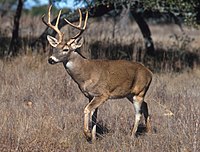
Photo from wikipedia
Abstract We investigated the palynology of sediment cores from Site M0027 (IODP Exp. 313), 45 km off the present-day coast of New Jersey to infer palaeoenvironmental conditions during the second half… Click to show full abstract
Abstract We investigated the palynology of sediment cores from Site M0027 (IODP Exp. 313), 45 km off the present-day coast of New Jersey to infer palaeoenvironmental conditions during the second half of the Mid–Miocene Climatic Optimum and the transition to global cooler conditions. In sum 79 taxa were identified via light microscopy (13 gymnosperms, 63 angiosperms, 3 pteridophytes), among them Diospyros and Reevesia , which until now have not been identified from the eastern coast of North America. Most of the identified taxa belong to the extended multi-layered broadleaved mesophytic forest that occupied the lowlands of the New Jersey hinterland and reflects the zonal vegetation during time of deposition. In higher altitudes or on edaphically drier slopes, the mesophytic forest was replaced by conifer forest. Landscape changes probably induced the spread and diminution of several vegetation units during the late Middle Miocene. An expansion of a conifer forest from ~ 15.8 to ~ 15.6 Ma is probably connected to the Appalachian uplift, and a subsequent spreading of Cupressaceae between ~ 15.0 and ~ 14.8 Ma probably reflects a period of enhanced inundation of coastal lowlands. The modern representatives of the main climatic elements among the encountered taxa are characterized by a typical temperate distribution. Climatic parameters (MAT, CMMT, WMMT, MAP) were calculated using bioclimatic analysis. In light of the ongoing discussion concerning identifications of Cupressaceae pollen grains, two different variations of the bioclimatic analysis were performed. Both variations indicate humid warm temperate climatic conditions with mean annual temperatures of ~ 13 °C ± ~ 5 °C, coldest month temperatures of ~ 4.3 °C ± ~ 5.3 °C, and warmest month temperatures of ~ 21.9 °C ± ~ 4.5 °C. Annual precipitation values exceed 1000 mm for all samples. Both zonal vegetation and the calculated regional lowland palaeoclimate show no significant changes. One factor creating generally climatically stable conditions between 15.8 and 12.7 Ma was likely the buffering effect of the Gulf Current loop.
Journal Title: Palaeogeography, Palaeoclimatology, Palaeoecology
Year Published: 2017
Link to full text (if available)
Share on Social Media: Sign Up to like & get
recommendations!